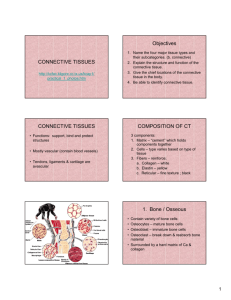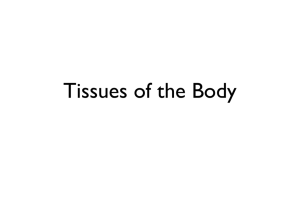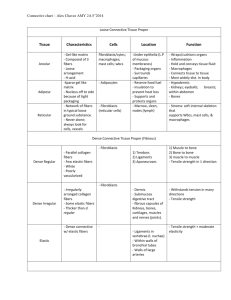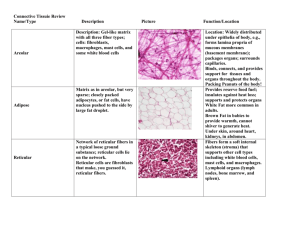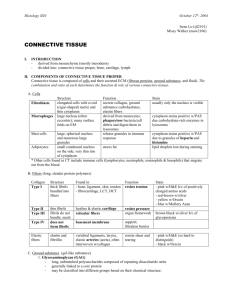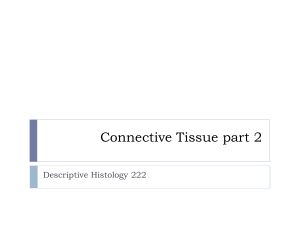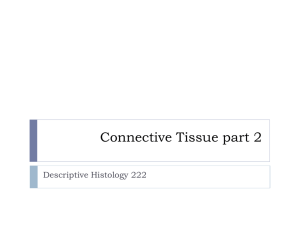Connective tissue Connective tissue is formed by the classes of 3
advertisement
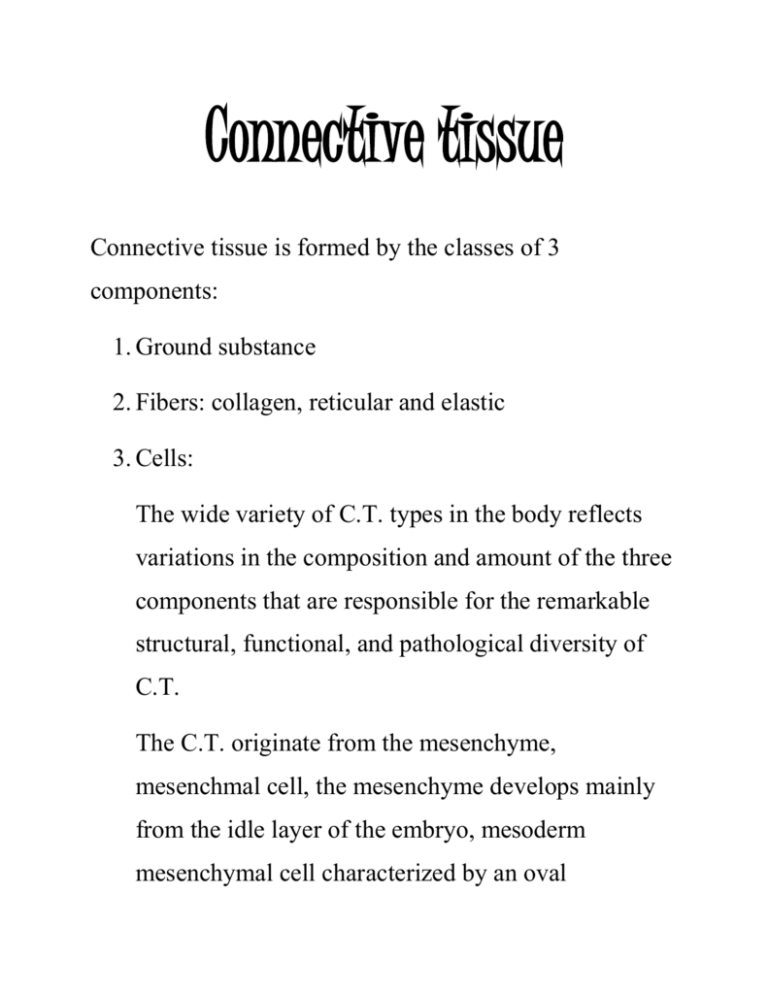
Connective tissue Connective tissue is formed by the classes of 3 components: 1. Ground substance 2. Fibers: collagen, reticular and elastic 3. Cells: The wide variety of C.T. types in the body reflects variations in the composition and amount of the three components that are responsible for the remarkable structural, functional, and pathological diversity of C.T. The C.T. originate from the mesenchyme, mesenchmal cell, the mesenchyme develops mainly from the idle layer of the embryo, mesoderm mesenchymal cell characterized by an oval nucleuswith prominent and fine chromatin. They possess many thin cytoplasmic processes and are immersed in an abundant viscous extracellular containing few fibers. Cells of the C.T. Fibroblast: synthesize collagen, elastin, glycosaminoglycan, proteoglycans and multiadhesine glycoproteins andare responsible for the synthesis of extracellular matrix component. Two stages of activity 1. Fibroblast 2. Fibrocyte Fibroblast is also involved in the production of growth factors that influence cell growth and differentiation. Myofibroblast, a cell with features of both fibroblasts and smooth m., and observed during healing their activity is responsible for wound closure after tissue injury, a process called wound contraction. Macrophage: characterized by phagocytic ability macrophage, monocytes are the same cell in different stages of maturation tissue, macrophages can proliferate locally, producing more cells. Macrophages, which are distributed throughout the body are present in most organs and constitute the mononuclear phagocyte system. Macrophages act as defense elements, and are also antigen-presenting cells that participate in the processes of partial digestion and presentation of antigen to other cells. Macrophages are also secretary cells that produce an impressive array of substance including enzymes e.g.: collagenase and cytokines. Mast cells:oval to round c.t. cells, cytoplasm is filled with basophilic secretary granules. The principal function of mast cells is to storage of chemical mediators of the inflammatory response. The secretary granules contain preformed mediators. 1. Histamine 2. Heparin 3. Highly acidic, sulfated glycosaminoglycan There are at least two populations of mast cells in c.t. 1. Connective tissue mast cell is found in the skin and peritoneal cavity, their granules contain the anticoagulant heparin. 2. Mucosal mast cell: is present in the c.t. of intestinal mucosa and lung, their granules contain chondroitin sulfate instead of heparin. Medical application Increased vascular permeability is caused by action of vasoactive substances an example is histamine, which is liberated from mast cells and basophilic leukocytes. Increases is blood flow and vascular permeability are responsible for local swelling (edema) redness and heat pain is due mainly to the action of chemical mediators on nerve ending chemotaks. The phenomenon by which specific cell types are affricated by some molecules is responsible for the migration of large quantities of specific cell types to legions of inflammation, leukocytes cross the walls of venules and capillaries by diapedesis, invading the inflamed wears. Plasma cells: are derived from B-lymphocytes and are responsible for the synthesis of the antibodies. Leukocytes: the normal c.t. contains leukocytes that migrate from the blood vessels by diapedesis. Diapedesis: leukocytes migrate through the walls of capillaries and post-capillary venules from the blood to c.t., this process increases greatly during inflammation leukocytes do not return to the blood after having resided in c.t., except for the lymphocytes that circulate continuously in various compartments of the body (blood, lymph, c.t., lymphatic organs). Adipocytes: these cells can be found isolated or in small groups within the c.t. itself. These cells become specialized for storage of neutral fats or for the production of heat Medical application Unilocular adipocytes can generate very common benign tumors called Lipomas. Malignant adipocytes-derived tumors liposarcomas are not frequent in humans. Fibers The c.t. fibers are formed by proteins that polymerize into elongated structures. Fibers are collagen, reticular, elastic the collagen and reticular are formed by the protein collagen and the elastic fibers are formed by protein elastin. These fibers are distributed unequally among the types of c.t. there are two systems of fibers. The collagen system consisting collagen and reticular fibers, and elastic system consisting of elastic, elaunin and oxytalan fibers. Collagen fibers:are the most abundant protein in the human body representing 30% of its day weight Collagen synthesis: an activity originally believed to be restricted of fibroblast, chondroblast, odontoblast, has now been shown that many cells types producing this protein the principal amino acids that make up collagen use glycine, proline, hydroxyproline. Collagen types 1. Collagen type I: thick found in dermis, tendon, bone dentin function resistance to tension 2. Collagen type II: loose aggregates of fibrils found in cartilage [Hyaline and elastic] function resistance to pressure 3. Collagen type III: thin, weakly found in skin, muscle, blood frequently together with type I Function: structural maintenance in expansible organs. 4. Collagen type IV: frequently forms fiber together with type I found in fetal tissues, skin, bone, placenta, most interstitial tissue function participates in type I collagen function. 5. Collagen type VI: small fiber found cartilage function participates in type II collagen function found also in basal lamina. Reticular fiber: Consist mainly of collagen type III. Reticular f. are extremely thin form an extensive network in certain organ they stained black by silver salts argyrophilic reticular f. abundant in smooth m., endoneurium and the frame work of hematopoietic organs. Elastic fibers: are composed of 3 types of fibers oxytalan, elaunin, elastic the structure of elastic fiber develop through 3stages. Subcutaneous tissue. (Elastic fibers labeled at right. ) Elastic fibres (or yellow fibres) are bundles of proteins (elastin) found in extracellular matrix[1] of connective tissue and produced by fibroblasts and smooth muscle cells in arteries. These fibers can stretch up to 1.5 times their length, and snap back to their original length when relaxed. Elastic fibers include elastin, elaunin and oxytalan. 1. Oxytalan: the fiber consists of abundle of microfibrils composed of various glycoproteins. oxytalan fibers can be found in the zonule fibers of the eye. 2. The second stage of development, an irregular deposition of the protein elastin appears between the oxytalanmicrofibrils forming elaunin. These structures found around sweat glands and in dermis. 3. During the third stage elastin gradually accumulates until it occupies center of fibers bundles. Ground substance: The intercellular ground substance is a highly hydrated colorless, transparent complex mixture of macromolecules it fills the space between cells and fibers of C.t. because it is viscous, acts as both a lubricant and barrier to the penetration of invaders. Grand substance is formed mainly of Glycosaminoglycans, proteoglycans and multiadhsive glycoproteins Prcteoglycan consist of numerous GAGs covalently bond to a core protein in a manner reminiscent of a test tube brush the entire proteoglycan may in turn be bound to the collagen and elastin fibers of C.T. Grand substance components Tissue fluid, minerals and proteoglycans Minerals; mostlycalcium salts tissue fluid: water, gases wastes nutrients which are transport from and to the cells of tissue Odema : pathologic condition is characterized by enlarged spaces, caused by the increase in liquid between the components of the C.T. Edema result from venous or lymphatic obstruction or from a decrease in venous blood flow heart failure or increased permeability of the blood capillary condition resulting from chemical or mechanical injury or the release of certain substances produced in the bodies e.ghistamine . Types of connective tissue : A.Loose C.T.: 1- Areolar C.T.: 2-Reticular C.T.: 3-Adipose C.T.: Embryonic connective tissue 1. mesenchyme : produce all permanent C.T2. mucous connective tissue : like mesenchyme but is a temporary it exists only in the fetus . mucous almost entirely limited to substance ( Wharton's jelly) mucous tissues have mainly fibroblast, reticular tissue: very delicate tissue forms network that support cells . areolar C.T.: found in every part of the body surrounds the B.V. , N., penetrate with the into the small spaces of muscles adipose tissue : occur singly or in small clusters in areolar t. the space between fat cells is occupied by areolar t., reticular t, blood capillaries . white fat ; adipose t. in adult yellow ( brown fat ) : adipose t. in fetuses and infants , children . fat gets color from an unusual abundance of blood v. and lysosomes . it stores lipid in the form of multiple droplets rather than one large one . obesity : is regarded as a condition in which a person as more than 20% above the ideal weight for his or her sex , age . hypertrophic obesity: excessive a accumulation of fat in unilocular t. cells that become larger them usual hyperplastic : an increase the number of adipocytes lipomas : benign tumors which is generate from unilocular adipocytes liposarcomas : malignant adipocyte derived tumors , are not frequent in human 4-Mucous C.T.: 5-Elastic C.T.: B-Dense C.T.: 1- Irregular C.T.: 2-Regular C.T.:
